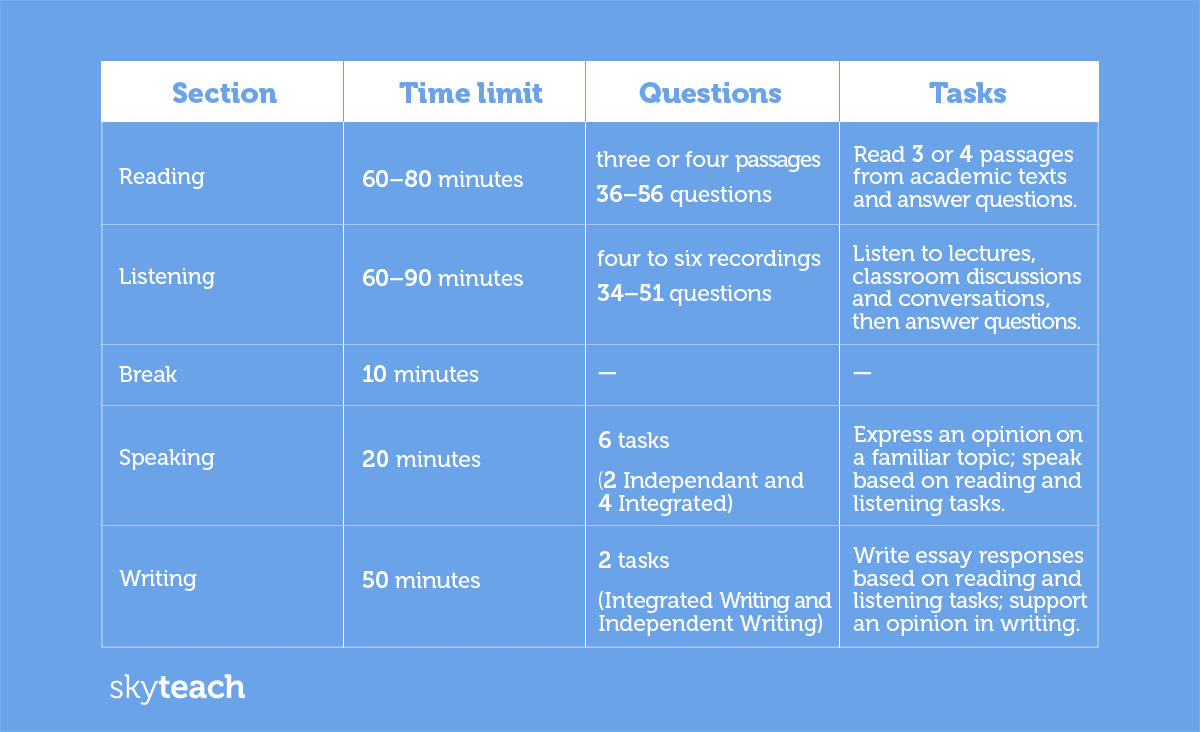If your students need to take an exam to prove their level of English, the TOEFL and IELTS are two of the most popular options. While some institutions accept only the IELTS or the TOEFL (so students have no choice), others accept both and here problems begin. What should you do if you students can’t make up their minds and can’t choose what exam to take, the TOEFL or IELTS?
Both the IELTS and TOEFL are valid for two years and test the same major areas. However, the way in which they test is not exactly the same. In this article you can find the most important differences between the TOEFL and the IELTS. While reading through them, think about what exam seems better suited to your students’ strengths. Moreover, give a practice test for each exam and see which one your students feel more comfortable with.
What is TOEFL?
The TOEFL (Test of English as a Foreign Language) is an English language proficiency exam produced by the ETS. There are two versions of the exam: paper-based and computer-based. We will focus on the TOEFL iBT, which is the most commonly taken and accepted version of the TOEFL.
The TOEFL lasts a total of 3.5 hours and includes four sections (Reading, Listening, Speaking, Writing). For each section, examinees receive a score of 0-30. These scores are then added together, total TOEFL score will be from 0-120.
What is IELTS?
More about IELTS here.
TOEFL VS IELTS
Difference 1: Computer-Based vs. Paper-Based exam format
Even though there are two version of the TOEFL, paper-based and computer-based, almost everyone who takes the TOEFL will do so on the computer. You are allowed to take notes on scratch paper, but all your official answers will be submitted on the computer (and Writing section too!). The IELTS, on the other hand, is mainly offered with pencil and paper (computer — based is possible at many test locations as well).
If your student is faster at typing than writing, have messy handwriting and/or prefer computers over paper tests, they may prefer the TOEFL. If they prefer writing out their answers, feel more uncomfortable with computer-based tests, and/or aren’t as familiar with English language keyboards, they may find the IELTS easier.
Difference 2: Computer-Based Speaking vs. Oral Interview
On the TOEFL Speaking section, students hear recorded questions and speak into a microphone to give answers. With the IELTS, students have a real life interaction with an examiner.
This is one of the biggest differences and it’s an important one to consider. Some people find speaking to a real person more nerve-wracking and would prefer the TOEFL, while others find it easier and more natural to have an actual conversation with a person, rather than speaking into a void for several minutes.
Also, the Speaking section on the TOEFL is always the third part of the exam, while, with the IELTS, you can take this section up to a week before or after the rest of the test. Some people prefer to get the exam over with all in one sitting, while others prefer to break the exam up into more manageable pieces.
Difference 3: Listening section
The IELTS test starts with the Listening section (passages of everyday social context, an educational context, and one that is a university lecture) and for some people it is easier to concentrate at listening at the very beginning of the test.
While in the IELTS examinees first see the question first and then listen (definitely, much easier to find the answers as students know what they should listen to and pay attention to), in the TOEFL (classroom lecture or a discussion between two students or a student and teacher) it’s vice versa — students listen to the recording, take notes and just then see the questions.
Difference 4: Multiple-Choice vs. Short Answer
A key difference between the exams for the Reading and Listening sections, is that students have to write their own answers for many of the questions on the IELTS, while most of the answer choices will be given to you on the TOEFL.
As an example, both exams have questions where students have to create a properly ordered list of events or steps. On the TOEFL, the steps are already given, and examinees just have to put them in the proper order. For the IELTS, they have to write the steps on thier own and properly order them.
Difference 5: Texts Used for the Reading Section
The two exams use different types of texts for the Reading sections. The IELTS uses academic texts, passages from newspapers and magazines. The TOEFL only uses academic texts with more challenging vocabulary and concepts to understand. If your students are not confident with their English reading skills or academic texts, they may find the IELTS Reading section to be easier.
Difference 6: How are they marked

Although the IELTS and TOEFL exams are assessing the same thing, the marking of the exams works slightly differently. On the TOEFL, test takers each receive four scores (one each for Reading, Writing, Listening, and Speaking) on a scale of 0-30 in 1-point increments. These four scores combine for a total TOEFL score out of 120 points. On the IELTS, test takers each receive four separate “band” scores for Reading, Writing, Listening, and Speaking on a scale of 0-9 in half-point increments. The total IELTS band score is the average of these four scores, and so it uses the same scale of 0-9. For example, if you were to score 8 on Reading, 7 on Writing, 5 on Listening, and 6 on Speaking, your total IELTS band score would be (8+7+5+6)/4=6.5, total IELTS scores always round to the nearest half-point.
Other factors to consider:
- Students should choose a test according to testing center location and a better option of available test dates. Check out the test dates and test locations for the TOEFL or IELTS to learn more.
- The cost of each test. Both exams generally cost about $200-$250, but they have different costs depending on the country where you take the exam.
Here is a short test for your students to take to find out which exams would be better for them (the test is adapted from Magoosh). Ask your student to answer the following questions with “yes” or “no”:
- I am comfortable with computers. YES/NO
- I can type quickly. YES/NO
- I am comfortable speaking extemporaneously into a microphone. YES/NO
- It is easy for me to take notes from a recording. YES/NO
- I feel comfortable listening to the lecture, taking notes and then answering the questions. YES/NO
- I prefer standard American English. YES/NO
- I prefer having more multiple-choice questions or questions where I only have to select an answer from a list of options. YES/NO
- The authentic English sources I read/listen to/watch are usually intended to inform rather than entertain. YES/NO
- I have enough patience to sit for 4 long hours . YES/NO
If your student answered ‘yes’ to most of these questions, the TOEFL is probably the best fit for his/her skill set.
- I prefer tests with many question types, including multiple choice, fill-in-the-blank, matching, true/false, and flowcharts. YES/NO
- I am good at british way of spelling. YES/NO
- I am comfortable having a detailed interview in-person. YES/NO
- I type slowly and feel uncomfortable using English keyboard. YES/NO
- I have legible English handwriting. YES/NO
- I can understand a variety of dialects of English. YES/NO
- I prefer face-to-face communication, rather than recording into a microphone. YES/NO
- I feel most comfortable discussing non-academic topics in English. YES/NO
- The authentic English sources that I read/listen to/watch are usually made to entertain. YES/NO
- I feel comfortable analyzing diagrams. YES/NO
- I feel it difficult to concentrate at the exam longer than 2 hour 30 minuts. YES/NO
If your student answered ‘yes’ to most of these questions, the IELTS is probably the best fit for his/her skill set.
The TOEFL and IELTS are the two most commonly administered English language proficiency exams. Both test the same four areas, but the tests vary in terms of format and the way they test skills.
Which exam do your students often take? Write in comments






 Анна Тетерина
Анна Тетерина 
 Анастасия Юферева
Анастасия Юферева 


